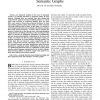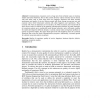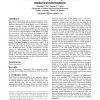241 search results - page 43 / 49 » Understanding Social Networks Using Formal Concept Analysis |
BMCBI
2010
13 years 7 months ago
2010
Background: Phylogenies capture the evolutionary ancestry linking extant species. Correlations and similarities among a set of species are mediated by and need to be understood in...
TKDE
2008
13 years 7 months ago
2008
An important problem in the area of homeland security is to identify abnormal or suspicious entities in large datasets. Although there are methods from data mining and social netwo...
JUCS
2008
13 years 7 months ago
2008
: Communications ecosystem covers a huge area from technical issues to business models and human behaviour. Due to this extreme diversity various societies need to discuss with eac...
CSUR
1999
13 years 7 months ago
1999
The Web can be naturally modeled as a directed graph, consisting of a set of abstract nodes (the pages) joined by directional edges (the hyperlinks). Hyperlinks encode a considerab...
WOSP
2005
ACM
14 years 1 months ago
2005
ACM
The change of focus from code to models promoted by OMG's Model Driven Development raises the need for verification of nonfunctional characteristics of UML models, such as pe...



